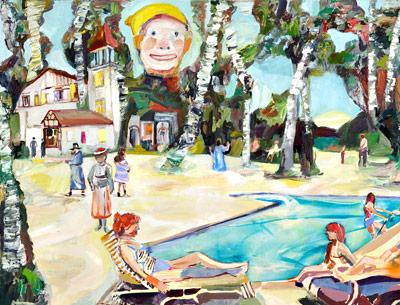Then Eden Falls Away

A viewer doesn’t need to know Elizabeth Huey’s complicated relationship with psychology to sense something not quite right in the superficially sunny images on the walls at Harper’s Books in East Hampton.
A large selection of the artist’s acrylic- and oil-on-wood paintings as well as some of her mixed-media works on paper were chosen by Jess Frost for an exhibition titled “Radiant Swim.” Albeit brighter than her earlier works, they resemble them in ways obvious and surprising. They are, like her other paintings, composites of different photographs, some taken by the artist and others found snapshops, collected over time.
The light in her sun-splashed images is excruciatingly and inescapably radiant, the kind of light chosen to make cockroaches scurry. The settings and clothing are decidedly retro, not surprising when one views the photographs on display in vitrines in the gallery, curling up at the edges with date stamps mostly from the mid-20th century, but also much earlier as well. The photos are predominantly of a postwar United States, with implications of great aspirations and nascent unrest.
At this gray and chilly time of year, it is tempting to take in the paintings with a sidelong glance and blissfully glide among them, stopping only briefly to take in their vibrant palettes. Yet with the accretion of images, one begins to discern a parallel plane on which these works operate. It is highlighted by the artist’s use of materials, the acrylics absorbing light and adding a rough texture while the oils encourage a glossy slippage of surface.
Downstairs in the front room, it’s all fun and games. There are Ping-Pong, “sauna domes,” diving boards, and soft-winded sails. The mind is lolled by the tranquility, the respite. Water lies at the center of each painting, providing a wet refuge, a cooling liquid middle, a purifying balm. Does one need to know that in a more harrowing series of paintings Ms. Huey depicted Sigmund Freud and Carl Jung playing billiards as taken from a 1909 photograph? Not quite yet. The weight of her earlier series dealing with the abuses of early mental health care and the not always successful attempts to rectify them, do not really reveal themselves in full flower until later in the show.
Downstairs, the only overtly menacing setback in the paintings might be a sunburn as in “Terrace at Dawn.” In “Observation Pool,” a rendering of the 1960s equivalent of the swim-up bar, made memorable in a scene from the 1983 film version of Tom Wolfe’s “The Right Stuff,” what could be more relaxing than having a dry martini while others cavort and recreate in the water around you and for you? The substance of her subjects begins to be felt upstairs when they trigger the mind to begin thinking in terms of objective correlatives.
Once in the mezzanine gallery, paintings such as “Haven for the Tender Hearted” offer a more twisted and uncanny take on the same themes explored downstairs. A colossal doll head looks down on yet another pool, with loungers and swimmers in modern bathing attire. Just off to the side of the pool, however, some of the trademark imagery of Ms. Huey’s earlier series is in evidence. There are women in garb from much earlier decades, a vaguely institutional Tudor-style structure, and the aforementioned gigantic head (given some explanation through a photograph of a similar head as some sort of beachside amusement in a nearby vitrine). Even more noteworthy from a contemporary perspective is a blue-robed figure that to anyone steeped in Renaissance-era imagery looks mighty Christ-like, holding a hand up in a gesture of benediction. That he is diminutive compared to the apparently “false idol” looming above starts to raise all kinds of lines of inquiry about this picture.
Once that threshold is crossed, Eden falls away and nothing in the other paintings ever looks the same again. “Bath Ablaze” could be a chic sunset-dappled Eero Saarinen-designed setting from a film or a modern-day Hieronymus Bosch rendering of a soul on fire. While it’s up to the viewer, the artist’s title is suggestive of a more menacing allusion.
Hints of a transgressive intent are also evident in the drawings where an accumulation of clothed and nude figures suggest a multitude of moods, personae, and symbols, heavily fraught and deeply psychological.
In the end, there is still free will and it is up to viewer to decide where and how these works will take them. What will you be having today? A day at the beach or a dark night of the soul? The gallery takes the order and the artist serves it up, at least until Feb. 18.
